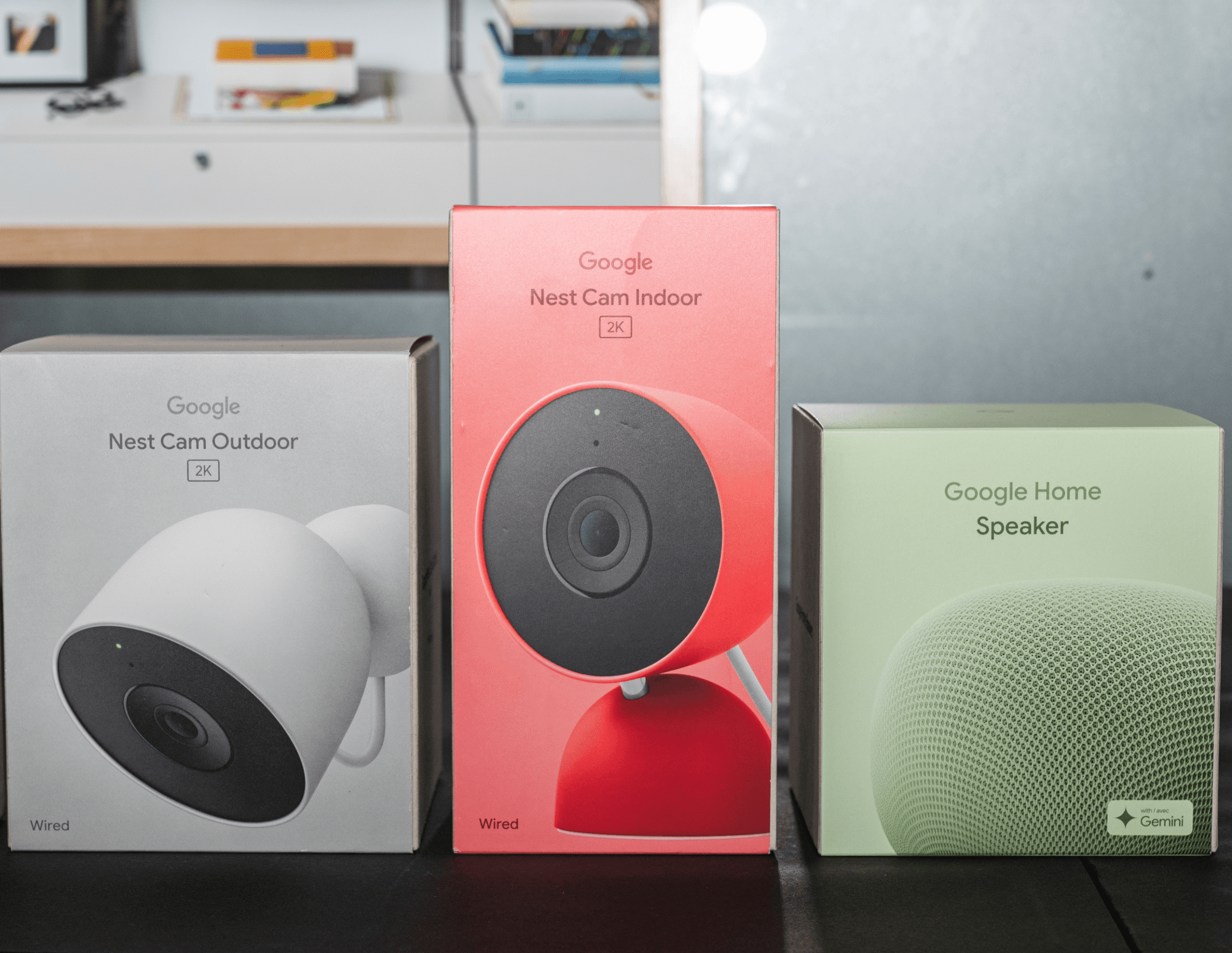Gemini Arrives in Google Home With New Nest Cameras and a Smart Speaker
Gemini replaces Assistant in your smart home, as Google redesigns the Home app and launches a new generation of Nest devices.

Photograph: Julian Chokkattu
All products featured on WIRED are independently selected by our editors. However, we may receive compensation from retailers and/or from purchases of products through these links. Learn more.
Google has spent much of this year porting its Gemini chatbot to other platforms outside of Android. It arrived on Wear OS smartwatches this summer; it’s coming to Android Auto this fall; but now it’s Google Home’s turn. Say goodbye to Google Assistant, which has powered many of Google’s smart home products since its 2016 debut. The command word remains, “Hey Google,” but now it’ll activate Gemini.
Nearly 10 years ago, Google Assistant was the company’s answer to Amazon’s Alexa. It kick-started a voice assistant war, but after a period of stagnation, these chatbots have been revived with the advent of large language models. You can talk to them more conversationally without being restricted by rigid commands, which marks a step-change in how we interact with voice assistants in the home. Creating a routine—a task the average person might find a tad too complicated—is now as simple as asking Gemini to “Turn on the lights and close the shades, and turn on the sound machine every night at 9 pm.”
Along with Gemini’s infusion, the Google Home app is getting a redesign to make use of its new capabilities, and there are new devices as well: a Google Home Speaker ($100), Nest Cam Indoor 2K ($100), Nest Cam Outdoor 2K ($150), and Nest Doorbell 2K ($180). Walmart is also partnering with Google to offer an uber-cheap indoor camera and doorbell with its Onn brand, both of which can be added directly via the Google Home app.
These products are available for purchase today, though the Google Home Speaker launches early 2026. Here’s what you need to know.
The Gemini Upgrade
.png)
Nest Outdoor Cam 2K (top left), Nest Doorbell 2K (bottom left), Google Home Speaker (center), and Nest Indoor Cam 2K (top right).
Photograph: Julian Chokkattu
When Google Assistant debuted on the original Google Home speaker, the company promised an ambient computing experience that would deliver an intelligent home, but the reality didn’t meet expectations. Google Assistant and Amazon’s Alexa are really great at telling you the weather, but they’re not quite as proactive as we wanted them to be.
“The AI at the time—the machine learning of the last generation—really was the limiting function,” says Anish Kattukaran, head of Product for Google Home and Nest. “As we think about this next era, the vision is still very much the same—to give people a partner in their home that can act as an extension of them to do things for them and make their lives a little better, and Gemini is well-positioned to do that.”
Adding Gemini to Google Home isn’t the same as adding Gemini to your phone or watch. You don’t use your home the way you use a phone; it’s not active, but ambient. And it’s not just for you, it has to be designed for everyone in the home, whether that’s a spouse, visiting parents, guests, or kids.
The first major change you’ll notice coming from Google Assistant is that the assistant sounds more natural. There are 10 new voices to choose from, and you’ll be able to chat with Gemini without being restricted to specific commands. You can also continue talking to Gemini about a topic, and it will understand the context, so you don’t have to keep repeating the subject matter. The answers it delivers are richer, and you won’t get routed to Google Search results as much.
Google is taking the opposite approach to Amazon when it comes to availability for its new souped-up assistant experience. Whereas Amazon says the fastest way for you to access Alexa+ is by buying one of the new Echo devices it announced yesterday, Google is prioritizing existing devices first. This month, Gemini will launch on every Google Assistant smart home device from the last decade, from the original 2016 Google Home speaker to the Nest Cam Indoor 2016. It’s rolling out in Early Access, and you can sign up to take part in the Google Home app. (Support doesn’t include third-party devices like Lenovo’s smart displays, which Google stopped updating in 2023.)
Google is bringing Gemini Live to select Google Home devices (the Nest Audio, Google Nest Hub Max, and Nest Hub 2nd Gen, plus the new Google Home Speaker). That’s because Gemini Live has a few hardware dependencies, like better microphones and background noise suppression. With Gemini Live, you’ll be able to have a back-and-forth conversation with the chatbot, even have it craft a story to tell kids, with characters and voices. At present, Gemini Live can’t perform actions, so you’ll need to exit the Live session to ask Gemini to turn off the lights. However, Kattukaran says adding actions to Live is on the roadmap.
Gemini is also able to handle complex automations for you, plus chained commands. You can ask it to close the garage door, turn off the lights, and turn on the TV in one breath. And routines are as easy as just asking it to repeat an action every night; no need to fuss with a routine tool. Part of this is tied to a new feature in the Google Home app called Ask Home. It’s where you can ask Gemini what happened while you were out, and the assistant will tell you how many packages arrived or whether your kid broke a vase in the backyard. You’re even able to ask data about home device usage consumption, like “How many hours of TV did I watch this weekend?” (Maybe don’t answer that.)

Nest Cam Outdoor 2K.
Photograph: Julian Chokkattu
If your Google Home ecosystem is powered by security cameras, they’ll now get richer notifications. Instead of “Person seen,” Gemini can be far more descriptive. This influx of more precise information is also summarized every evening via a feature called Home Brief in the Home app (more on this below).
However, some of these new capabilities are locked behind a subscription. Gone is the Nest Aware subscription in favor of a new service called Google Home Premium, and there are two plans to choose from.
- The Google Home Premium Standard subscription at $10 a month or $100 a year includes Gemini for Home, Gemini Live, Automation features, and also 30 days of event history for Nest cameras, intelligent alerts, and familiar faces. This tier is included as part of Google AI Pro.
- The Google Home Premium Advanced subscription at $20 a month or $200 a year adds the Ask Home feature, AI notifications and descriptions, and the Home Brief, alongside 60 days of event history or 10 days of 24/7 recording. This tier is also included as part of Google AI Ultra.
The Google Home App Redesign

The redesigned Google Home app.
Courtesy of Google
Redesigned and simplified, the new Google Home app consists of three tabs with a persistent header search bar, called Ask Home, that you can use to find what you’re looking for:
- Home shows all your favorite devices, and you can customize the view and swipe into the various dashboards to control your lights, cameras, and everything else.
- Activity shows a history of your home with a summary from Gemini and a host of filters to enable you to manage the data.
- Automation organizes your automations, which can now be created conversationally using Gemini, into chronological order, so you can see what’s scheduled to happen in your home.
The Google Home app has seen a host of small improvements over the last few months to enhance stability and polish. However, Google says with this new update, you can expect to see 70 percent faster startup with the app and 80 percent fewer crashes. There are battery life and memory optimizations, and scrubbing through the camera is six times smoother. The Home app is designed to be used easily one-handed, and you can use more gestures, such as swiping down to enter a camera view or swiping up to back out.
You now get preview images from the last event before the live view loads, the ability to swipe between timeline and events, double-tap to fast forward or rewind, and better notifications with a static thumbnail expandable to a large animated preview.
Google says the merger of features and devices from the old Nest app is now complete, and folks should be able to transition seamlessly, though the legacy app won’t be disappearing yet.
New Nest Cameras

Nest Doorbell 2K.
Photograph: Julian Chokkattu
Google unveiled three new wired Nest devices, the Nest Cam Outdoor ($150), Nest Cam Indoor ($100), and Nest Doorbell ($180). All of them jump from 1080p to 2K resolution, and retain the same high frame rate (30 fps) and HDR support as the previous generation. This resolution bump enables you to zoom in on details like car license plates, but it also provides far more data for Gemini to analyze and interpret (more on that in a moment). They have bigger sensors for more accurate detection, come in a variety of new colors, and they have a special resin coating that guards against UV discoloration (the outdoor cameras are IP65-rated).
The Nest Doorbell features some important upgrades. To ensure you get the complete picture of what’s happening at your front door, this video doorbell has an enhanced field of view (from 152 degrees to 166 degrees) and switches to a 1:1 aspect ratio. But when you get a notification, the preview will zoom in on whatever triggered the event. You can zoom and crop to focus on the areas you want in the Home app. All of the new cameras feature 6X digital zoom.
The new wired Nest Doorbell is only available in the US and Canada for now, and comes in Snow, Hazel, or Linen. The Nest Cam Indoor is available in a wide variety of markets, including the US, UK, and Japan, and comes in Snow, Hazel, or a bright red Berry, but those last two colors are US-only. The Nest Cam Outdoor is widely available and comes in Snow or Hazel (US-only), and you can snag a two-pack of the Nest Cam Outdoor for $250.

Nest Indoor Cam 2K.
Photograph: Julian Chokkattu
Why the bright red? Kattukaran says there’s a shift in interior design from muted colors to brighter tones and pops of color, so the company wanted to offer a bold option. It’s very uncommon to see a red security camera!
Despite the higher demands of 2K footage on your Wi-Fi, Google has gone with dual-band Wi-Fi 5 in these new security cameras, instead of Wi-Fi 7. You will need a fairly strong signal to stream in 2K (at least 3.3 Mbps).
As touched on before, more important than the hardware upgrade is what’s going on under the hood. With the addition of Gemini AI on the software side, your notifications about a person or package being detected are going to get a whole lot more descriptive. Gemini can watch the footage and determine that FedEx dropped off a package or tell you when your kids got home.
You can ask Gemini more detailed questions, like, “Why is the plant on the floor?” and find out that the cat was the culprit. You can even get a home brief at the end of the day that presents a kind of highlight reel, and you can tweak that brief to focus on your kids or pets or whatever you want. But many of these features require a subscription.

Walmart Onn Google Home cameras.
Photograph: Julian Chokkattu
Each of the new Nest cameras comes with six hours of event history in 10-second video clips for free, but if you want to unlock the AI capabilities, you’ll have to stump up for one of the new Google Home Premium subscription plans.
Google is also partnering with third parties on more Gemini for Home-compatible devices that will work in the Google Home app. The first partner is Walmart with the Onn Indoor Wired Camera ($23) and the Onn Video Doorbell ($50). Both are budget-friendly 1080p cameras.

Google Home Speaker.
Photograph: Julian Chokkattu
There hasn’t been a Google Home smart speaker since the Nest Audio in 2020, but that’s finally changing with the aptly named Google Home Speaker. It costs $100, and while the audio quality may not be as up to par as the larger Nest Audio, this device has a snazzy, round design made from a 3D knit recycled yarn that isn’t too different from the new Echo Dot Max. It’s arriving in the spring of 2026, and you can choose from four colors: Jade, Berry, Porcelain, and Hazel.
There’s an expressive light strip around the base to indicate when Gemini is listening or talking, and you get 360 audio from this little orb. Google says you can pair two of these together with the Google TV Streamer 4K for surround sound. Naturally, it can be grouped with other Nest speakers for stereo sound or multiroom music. There’s also a physical toggle to mute the microphone.
It has been a rocky road for Google’s smart home platform over the last few years, with a clunky transition from the Nest app, missing features, and a lack of polish in the Home app. Today’s announcements are a crucial step forward for its smart home ambitions, especially since the home voice assistant wars seem to be picking back up where they left off.



